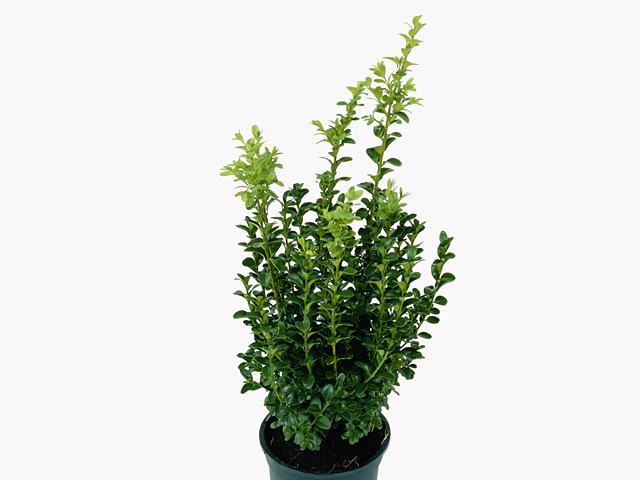Buxus sempervirens

| Leaf margin | Entire |
| Flower scent | Unscented |
| Leaf type | Foliage leaf |
| Winter hardness | Good (USDA-zone 5, 6) |
| Inflorescence | Raceme |
| Structure (tissues) | Woody |
| Leaf surface | Glossy |
| Leaf size | 2 - 3 cm |
| soil pH requirement | Neutral (pH 6,5 - 7,5) |
| Light conditions | Semi-shades |
| Leaf division | Simple |
| Plant, growth type | Erect |
| Leaf colour, pattern | Marginate |
| Toxicity (if consumed) | Highly toxic |
| Moisture requirements | Well-drained |
Boxwood, also known as Buxus sempervirens, is a popular shrub with a variety of characteristics that make it desirable for gardeners and landscapers. From its glossy leaves to its ability to withstand harsh winter conditions, boxwood is a versatile plant that can thrive in various environments.
One of the distinguishing features of the boxwood is its entire leaf margin, meaning the edges of the leaves are smooth and uninterrupted. This gives the shrub a clean and neat appearance, making it a popular choice for formal gardens and hedges.
In terms of scent, boxwood flowers are unscented, which can be a benefit for those who are sensitive to strong floral fragrances. Instead, the focus is on the shrub's attractive foliage, which consists of simple foliage leaves. These leaves have a glossy surface and a marginate color pattern, adding visual interest to the overall appearance of the plant.
Boxwood is a woody shrub that can withstand cold temperatures. It is listed as a good winter-hardy plant in USDA zones 5 and 6, meaning it can withstand temperatures as low as -20 to -10 degrees Fahrenheit (-28 to -23 degrees Celsius). This makes it an excellent choice for gardeners in colder regions who want to add greenery to their landscapes year-round.
When it comes to soil pH, boxwood prefers neutral conditions, with a pH range of 6.5 to 7.5. It is adaptable to different soil types but requires well-drained soil to prevent root rot. Proper drainage is crucial for the health and longevity of boxwood plants.
Light conditions also play a role in the successful growth of boxwood. These shrubs thrive in semi-shade environments, where they receive dappled sunlight or partial shade throughout the day. Full sun exposure can lead to leaf burn and stress the plant, so it is essential to provide some shade to protect it.
Although boxwood is highly toxic if consumed, it is generally safe to have in a garden as long as precautions are taken to prevent ingestion by pets or children. It's crucial to educate oneself about the potential risks and ensure the shrub is kept out of reach.
In terms of growth habit, boxwood is an erect plant that grows in an upright manner. Its compact nature and slow growth make it an ideal choice for formal hedges and topiaries, as it can be easily trimmed and shaped to maintain a specific size and structure.
Overall, boxwood is a versatile and visually appealing shrub that can thrive in various environments. Its glossy leaves, neat appearance, and tolerance to cold temperatures make it an excellent choice for both ornamental and functional purposes in gardens and landscapes. However, gardeners should be aware of its toxicity and take necessary precautions to keep it safe around children and pets.
Market availability index by month:
| Jan. | Feb. | Mar. | Apr. | May | Jun. | Jul. | Aug. | Sep. | Oct. | Nov. | Dec. |
|---|---|---|---|---|---|---|---|---|---|---|---|
| 2 | 3 | 3 | 4 | 4 | 3 | 2 | 3 | 3 | 3 | 2 | 1 |